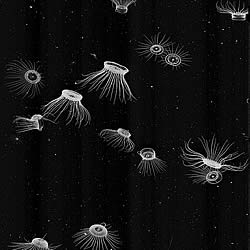
A dense aggregation of hydromedusa Solmaris rhodoloma found off the coast of Southern California. credit Bob Cowen University of Miami & OSU
Today, an online citizen-science project launches called "Plankton Portal" was created by researchers at the University of Miami Rosenstiel School of Marine and Atmospheric Sciences (RSMAS) in collaboration with the National Oceanic and Atmospheric Administration (NOAA) and the National Science Foundation (NSF) and developers at Zooniverse.org Plankton Portal allows you to explore the open ocean from the comfort of your own home. You can dive hundreds of feet deep, and observe the unperturbed ocean and the myriad animals that inhabit the earth's last frontier.
The goal of the site is to enlist volunteers to classify millions of underwater images to study plankton diversity, distribution and behavior in the open ocean. It was developed under the leadership of Dr. Robert K. Cowen, UM RSMAS Emeritus Professor in Marine Biology and Fisheries (MBF) and now the Director of Oregon State University's Hatfield Marine Science Center, and by Research Associate Cedric Guigand and MBF graduate students Jessica Luo and Adam Greer.
Millions of plankton images are taken by the In Situ Ichthyoplankton Imaging System (ISIIS), a unique underwater robot engineered at the University of Miami in collaboration with Charles Cousin at Bellamare LLC and funded by NOAA and NSF. ISIIS operates as an ocean scanner that casts the shadow of tiny and transparent oceanic creatures onto a very high resolution digital sensor at very high frequency. So far, ISIIS has been used in several oceans around the world to detect the presence of larval fish, small crustaceans and jellyfish in ways never before possible. This new technology can help answer important questions ranging from how do plankton disperse, interact and survive in the marine environment, to predicting the physical and biological factors could influence the plankton community.
"ISIIS gives us a new view on plankton, enabling us to see them in their natural setting, where they occur, what other organisms are nearby, even their orientation," explains Cowen.
The dataset used for Plankton Portal comes from a project from the Southern California Bight, where Cowen's team imaged plankton across a front, which is a meeting of two water masses, over three days in Fall 2010.
According to Jessica Luo, graduate student involved in this project, "in three days, we collected data that would take us more than three years to analyze." Cowen agrees: "with the volume of data that ISIIS generates, it is impossible for us to individually classify every image by hand, which is why we are exploring different options for image analysis, from automatic image recognition software to crowd-sourcing to citizen scientists."
"A computer will probably be able to tell the difference between major classes of organisms, such as a shrimp versus a jellyfish," explains Luo, "but to distinguish different species within an order or family, that is still best done by the human eye." Volunteer citizen scientists can assist by going to http://www.planktonportal.org. A field guide is provided, and the simple tutorial is easy to understand. Cowen and the science team will monitor the discussion boards; answer any questions about the classifications, the organisms, and the research they are conducting.
